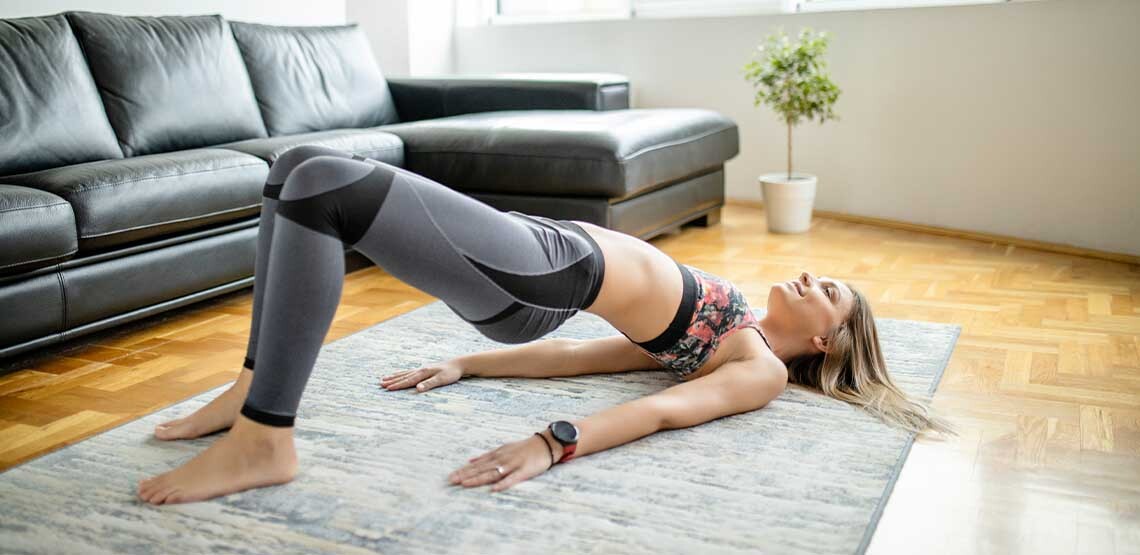Exercises to Help With Pelvic Floor
The pelvic floor is frequently neglected until it becomes a problem. In fact, most people don’t even know what it is.
Your pelvic floor is actually a collection of connective tissue, ligaments and muscles that support the bladder, bowel, vagina and uterus. However, it is not only women who have a pelvic floor — men do too.
Having a weak pelvic floor can quickly result in urinary incontinence and bowel issues in both sexes. In women, a weak pelvic floor might lead to a prolapsed uterus or bladder, which may require surgery and can cause pain during sex.
Thus, it is crucial to maintain the health and strength of this area of the body, ensuring you do not face any unwanted problems. So, how can you strengthen your pelvis? You can do so with a specific exercise to help with the pelvic floor.
What Causes a Weak Pelvic Floor?
A weak pelvic floor might result from pregnancy, childbirth, obesity, chronic constipation, or prostate cancer treatment.
A weak pelvic floor is further common with increasing age due to the role of collagen in the body. Collagen is important for the maintenance of connective tissues and muscles. Yet, with age, the body’s collagen production gradually slows, which can lead to the weakening of the pelvic floor.
This means that, with age, it is important to pro-actively work on strengthening your pelvic floor and pelvic muscles, so that you don’t experience disruptions to your quality of life or daily activities. Below, we outline a few pelvic floor exercises you might want to start performing on a regular basis.
Exercises for Your Pelvic Floor
The good news is that there are all kinds of exercises that are easy to perform at home to strengthen your pelvic floor. You can begin doing these daily to improve strength, then after a few months, you can drop down to two or three times a week. So, let’s dive in!
1. Kegels
Kegels are a popular exercise that target the pelvic floor. If you sneeze or cough and notice a bit of urine leak out, this is definitely an exercise you will want to keep in your regular rotation!
If you are unsure what your pelvic floor muscles even feel like, now is the time to get acquainted. Next time you urinate, stop mid-stream and feel for these muscles in between your hip bones. These are your pelvic floor muscles!
For Kegels, you are simply contracting and relaxing these muscles. When you contract and tighten them, hold them for five seconds, building up to a 10-second hold. Release for the same amount of time, then repeat for 10 to 15 repetitions and perform two to three sets.
2. The Glute Bridge
While this is primarily a glute exercise, it also targets your pelvic floor. Strong glutes can further support this part of the body, offering prevention against back and hip pain.
For this exercise, lie on your back on a comfortable surface. Bend your knees to 90 degrees and plant your feet flat on the ground. As you inhale, push your hips and glutes off the ground, pushing down through your heels.
From your chest to your knees, your body should form a straight line. Don’t forget to squeeze those glutes! Hold for three to five seconds, then release, and repeat for 10 to 15 repetitions and two to three sets.
Related Search Topics (Ads)
3. The Split Tabletop
This is actually a Pilates move that works the pelvic floor, abdominals and hip muscles. While it might feel awkward at first, focus on contracting these muscles and keeping your back flat against the ground for optimal results.
Start by lying face-up. Bend your knees and lift your feet off the ground, so that your knees are stacked over your hips with your thighs perpendicular to the ground. Brace your abs (or core), starting with your inner thighs just touching.
In a slow and controlled movement, spread your legs as far as you comfortably can, keeping your knees in the same bent position. In a slow and controlled movement again, bring your legs back to start. Repeat for 10 to 15 repetitions and two to three sets.
4. Squats
Compound movements, such as squats, help you bring that pelvic floor contraction into every day, functional movements. This can ensure that you are activating these muscles appropriately throughout your day.
For the squat, start by standing tall with your knees slightly bent. Contract your core and pelvic floor muscles. Slowly bend your knees, sticking your butt out and keeping your back straight. It might help to position your arms at shoulder height straight out in front of you to maintain balance.
Lower down until your thighs are parallel with the floor. Pause, then slowly push through your heels back up to standing, bracing your core and pelvic floor through the whole movement. Do 10 to 15 repetitions, two to three times a day.
In Summary
Regular pelvic floor exercise can help ensure you do not face urinary or bowel incontinence, or pain during sex, amongst other issues. While it might seem like work at first, pelvic floor exercise can easily become part of your regular routine where you don’t even second-guess doing them. Start scheduling exercise to help with your pelvic floor and begin taking back control of your health and your life.


